How Arena Sports increased Catalog Ads ROAS by 34% with Confect
March 17, 2025
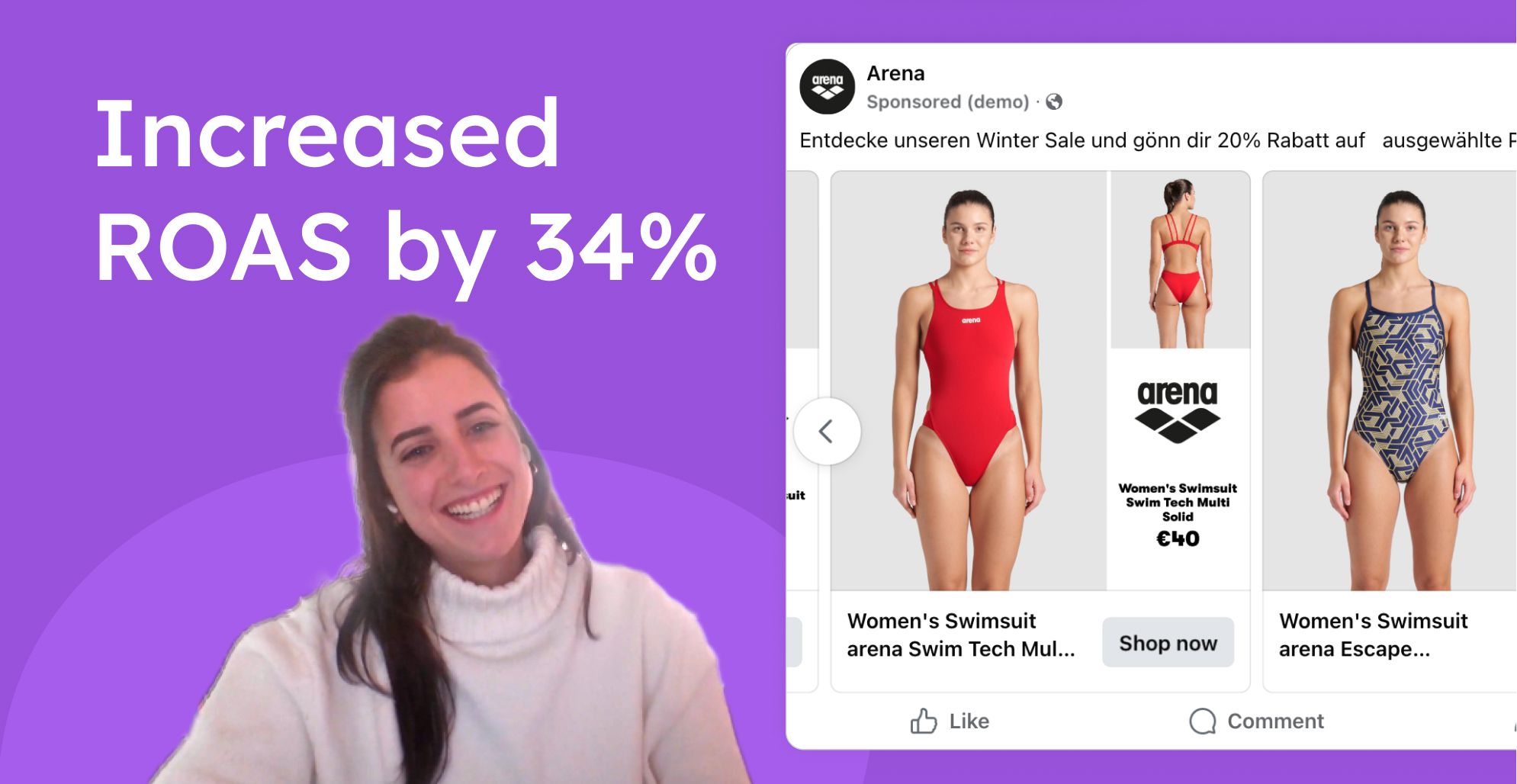
Arena is a renowned global swimwear brand that is represented in over 100 countries around the world.
Arena specializes in high-performance swimwear and accessories for competitive swimmers but also caters to amateur water sports enthusiasts.
Like most eCommerce brands, their Catalog Ads started looking like this:
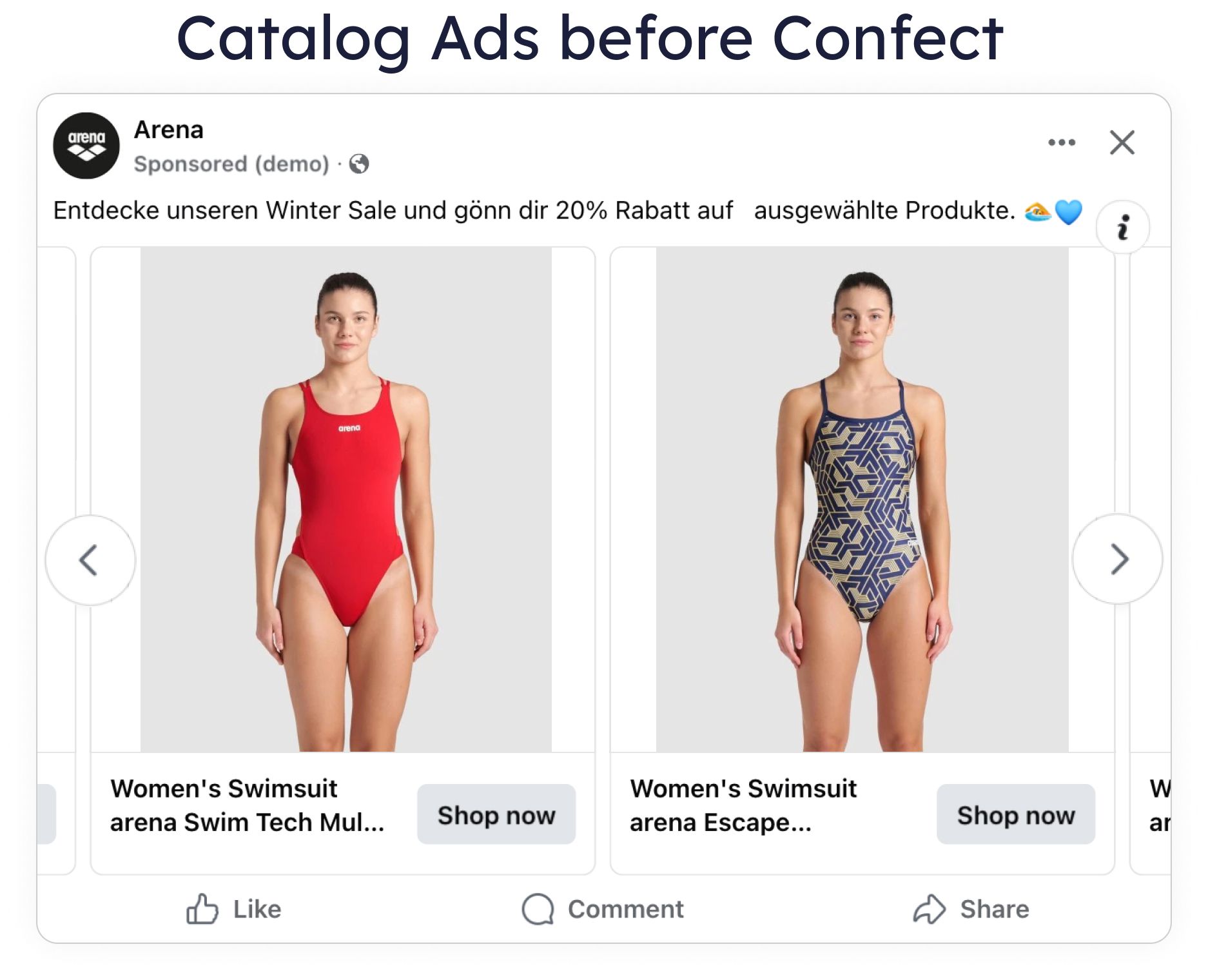
Arena has since then established a world-class Catalog Ads setup. Ensuring every ad is aligned with their broader marketing efforts. By carefully selecting the right information for each product and keeping designs consistent across all touchpoints. Their holistic approach is something every eCommerce brand can learn from.
We spoke with Arena's Performance Marketing Manager, Christiane Schwenk Lagun, about how they use Catalog Ads with Confect.
Arena's results using Confect for their Catalog Ads
Christiane shared four important tactics they implemented with Confect that helped them achieve these impressive results.
Testing multiple designs to find the best performers & added value from Confect designs
When Arena first started using Confect for catalog ads, they wanted to showcase products in the best way possible. Their goal was to provide relevant product information and prove that Confect’s designs would perform better
The first test was with their Winter Sales campaign, testing what would perform best: a default catalog ad with no Confect design, a catalog ad with the product image, the price & winter sales text, or a catalog ad with 2 product images and only a winter sales text.
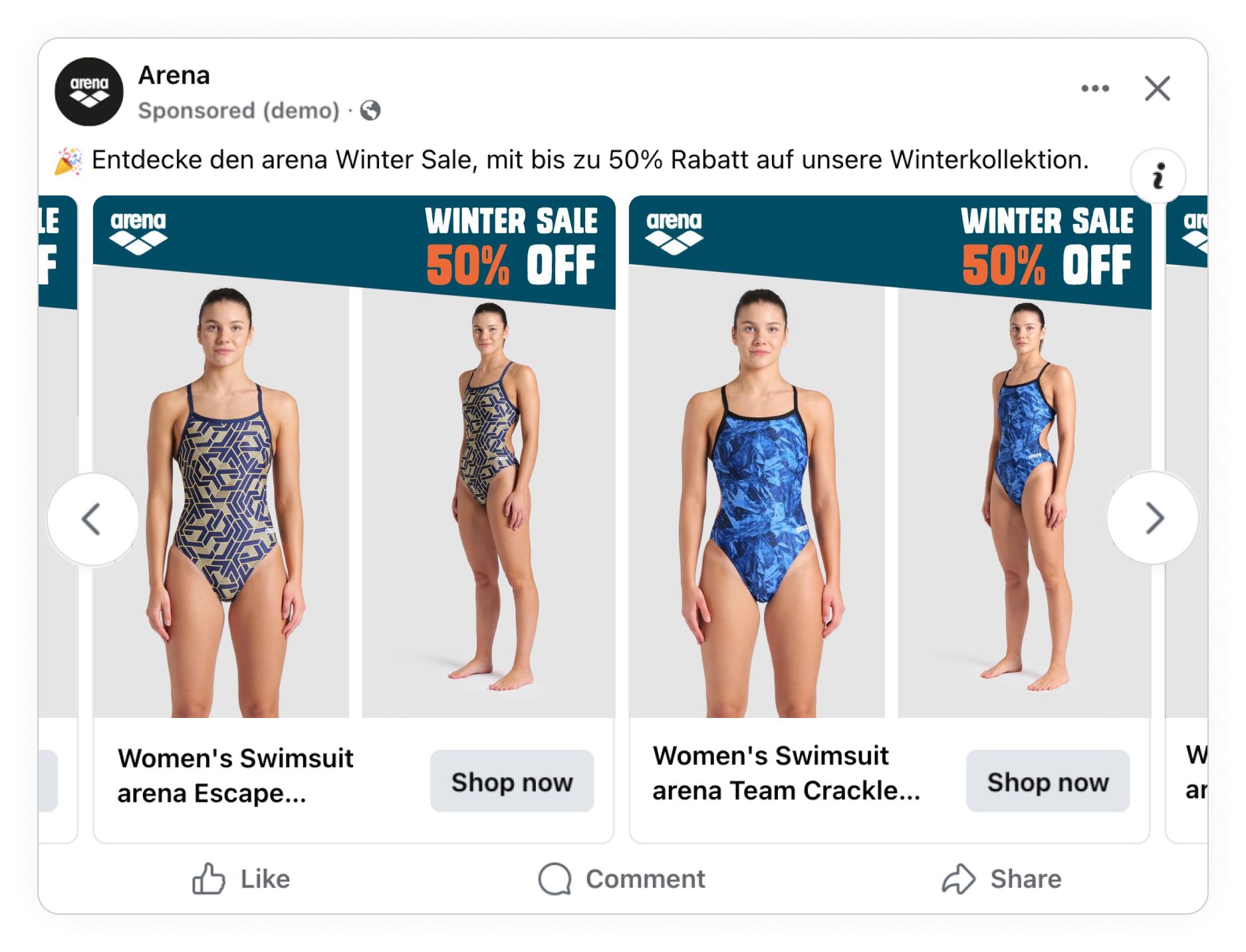
This design provided shoppers with a full view of the product, featuring a zoomed-in image that reveals more detail, along with an additional image showcasing the product on a full model image.
This was tested against a design that focuses more on the product information. It includes only a single product image but shows the product's actual price instead of only the sale message of up to 50% off.
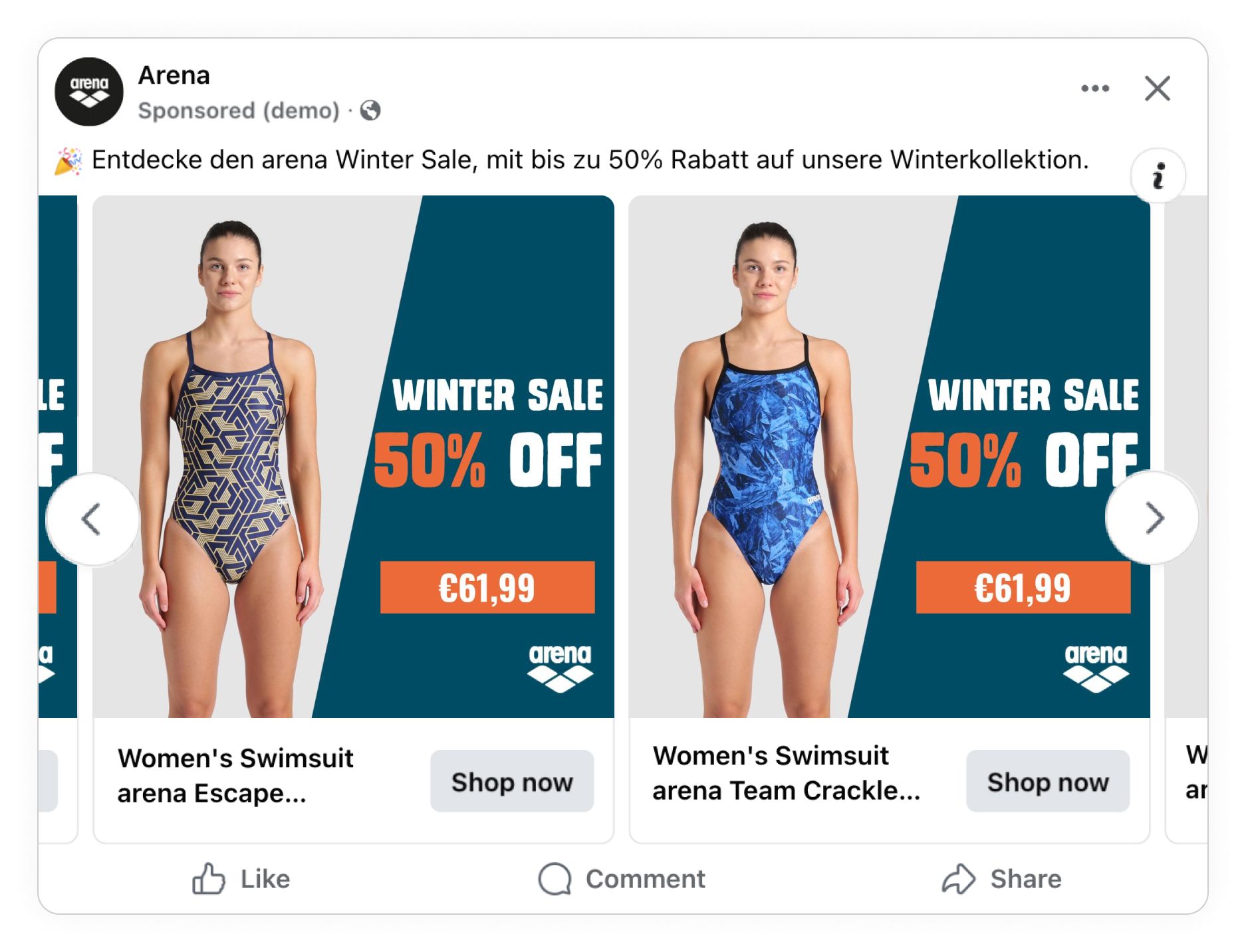
The test was conducted with all three variants, and the design with two additional images and no price performed the best.
Even though you might think that the design with more product information (i.e., the price) would be best, that's not the case. Ultimately, the design with two images and no price had a 34% higher ROAS & 18% higher CTR than the Catalog Ad with no Confect design.
This just goes to show how much value you can get from testing designs against each other, and it's a practice that Arena still use in their Catalog Ads, to always make sure they have the best performing Catalog Ads.
 Christiane Schwenk Lagun
Performance Marketing Manger @ Arena
Christiane Schwenk Lagun
Performance Marketing Manger @ Arena
Clever customization of designs for different product categories
Like many brands, Arena sells a wide range of products, from racing suits for professional athletes and casual swimwear to accessories like swim caps. Arena knows that not all products need to be shown the same way in Catalog Ads. The right design depends on what information helps customers make a decision.
For swimwear, customers need to see how it fits and looks when worn. That’s why Arena's Catalog Ads for swimwear include multiple images, showing both the front and back to highlight key details.
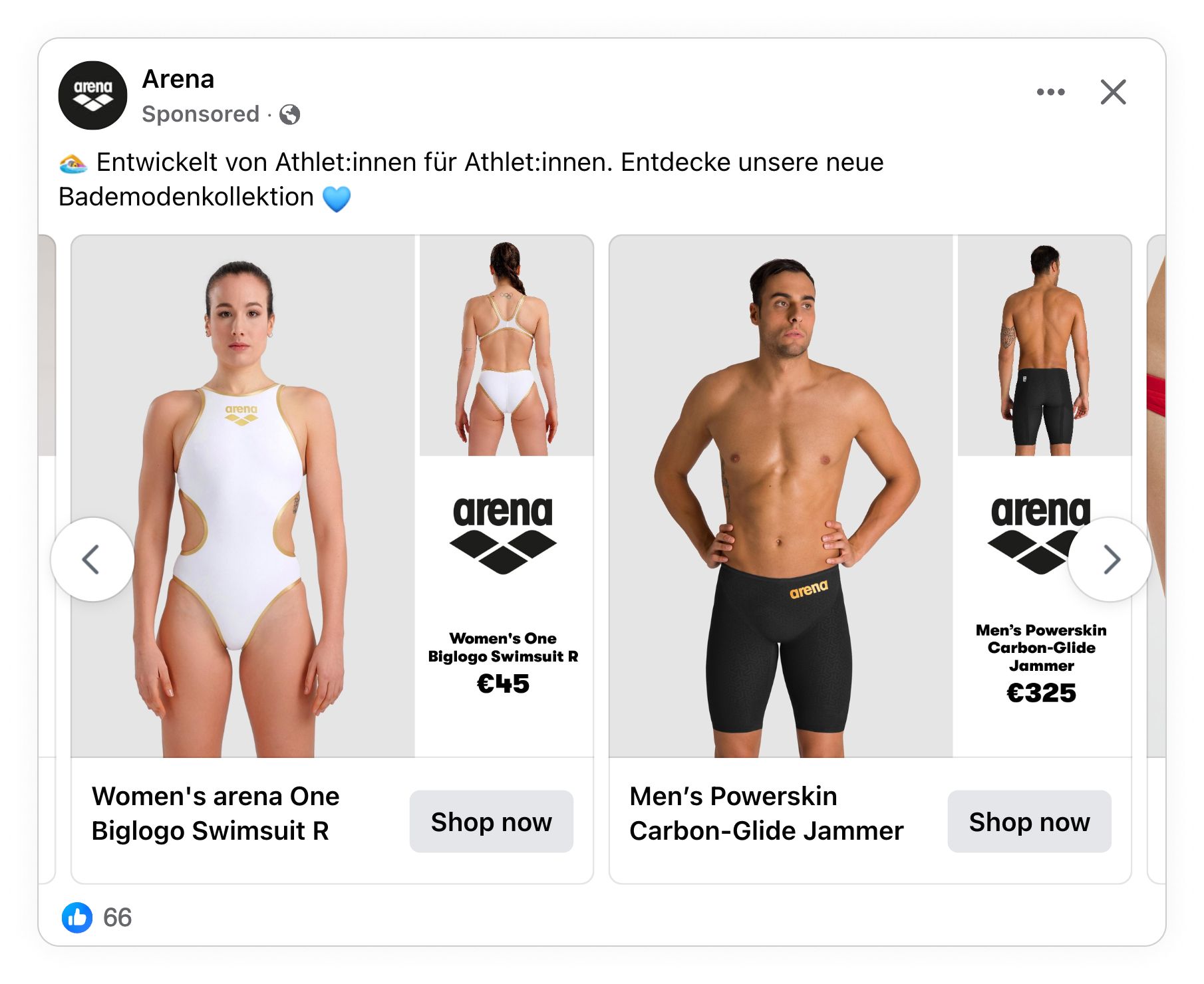
But what about products that don’t need to be seen in use? For example, a swim cap or a pair of swimming goggles doesn’t require a model. It’s a simple product, and the main concern for buyers is usually the design and price.
For these types of products, Arena uses a more minimal Catalog Ad. A clean layout with a big product image lets you easily see the cap’s color or pattern, and they're also giving the price a more significant place in the design. All this makes it easy for shoppers to compare and decide without unnecessary distractions.
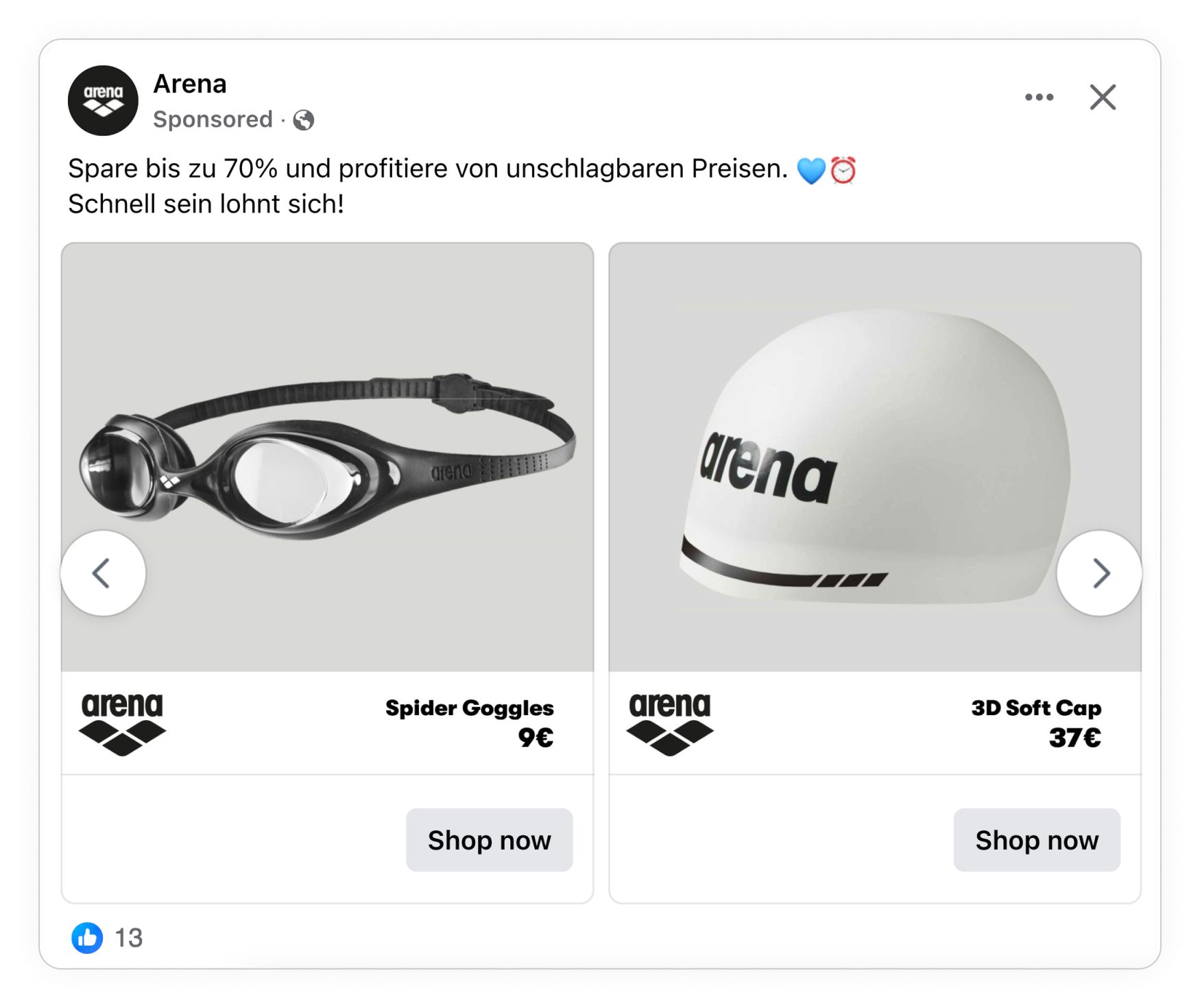
By adjusting Catalog Ad designs to fit different product types, Arena ensures that each ad is as effective as possible. Whether a performance swimsuit or a basic swim cap, the ad always highlights what matters most to the customer, helping them make faster and smarter purchase decisions.
Another benefit of customizing your catalog ad designs to the product categories is the product's physical size. Swim caps are much smaller than swimsuits, so using a larger, more zoomed-in image in the Catalog Ad helps highlight details like textures, patterns, and branding. If the image were too small, customers might miss these details entirely.
By designing Catalog Ads around what matters most for each product, Arena makes sure every shopper gets the correct information at the right time, and they’re seeing the success from it.
It's a simple set of rules inside Confect, that can be done on any type of product information, for instance, category (as in this case), brand, custom_labels, price, etc.
 Christiane Schwenk Lagun
Performance Marketing Manger @ Arena
Christiane Schwenk Lagun
Performance Marketing Manger @ Arena
Using Catalog Ads as a mini product page to bridge the gap from ad to website
One of Arena's always-on designs includes a miniature version of the product page from their website. Instead of overwhelming shoppers with too much information, they carefully selected the most essential details and designed the ad to mimic the product page visually.
By keeping the ad and product page consistent, they created a seamless experience. It feels natural when you click on the ad and go to the product page afterward.

In the Catalog Ad, they include:
- The first two images from the product page
- Their logo for brand recognition
- The product name
- The price
Focusing on the essentials gives the shopper just enough information to decide if they're interested in this product or not - and by using this in catalog ads, it gives the shoppers the ability to make this decision on multiple products quickly.
-1.jpg)
Once they land on the product page, they can explore more angles, color options, and size details, but by then, they should already be engaged. This level of consistency builds trust and, in general, eases the experience for shoppers.
By designing their catalog ads as mini product pages, Arena also made catalog ads work for different types of shoppers.
- Casual swimmers can get a quick overview and decide if they want to learn more.
- Serious swimmers/athletes looking for specific features - like the back of the swimwear - can see if this product fits their needs immediately.
By tailoring their Catalog Ads this way, Arena isn’t just driving clicks—they’re helping shoppers make confident purchase decisions before they even reach the website.
 Christiane Schwenk Lagun
Performance Marketing Manger @ Arena
Christiane Schwenk Lagun
Performance Marketing Manger @ Arena
Using Catalog Ads for campaigns and sales
Running large-scale promotions like Black Friday or Summer Sales isn’t just about offering discounts - it’s about making sure customers see the sale message loud and clear.
To do this, Arena built its Catalog Ads specifically for sales campaigns. Instead of focusing on product details like their always-on ads, they flipped the priority - putting the sale message front and center and ensuring every ad clearly showed the discount.
And even better, instead of creating new campaigns and ads for every sale, they easily integrate the sales message in their existing catalog ads.

For instance, take a look at the summer sales campaign above. They keep the same style as in their always-on catalog ads, with two model images so shoppers can see the product in context. This keeps the ad consistent with the brand’s everyday marketing, ensuring a familiar experience.
The key difference is that the product information they include in always-on catalog ads has been switched out with a big "summer sale" message, which is virtually impossible to overlook.
It’s a simple tweak, giving the Catalog Ad an entirely new purpose. Instead of focusing on just the product, the ad now focuses on the sale itself, creating urgency and excitement, and shoppers immediately know that they can make a good deal here.
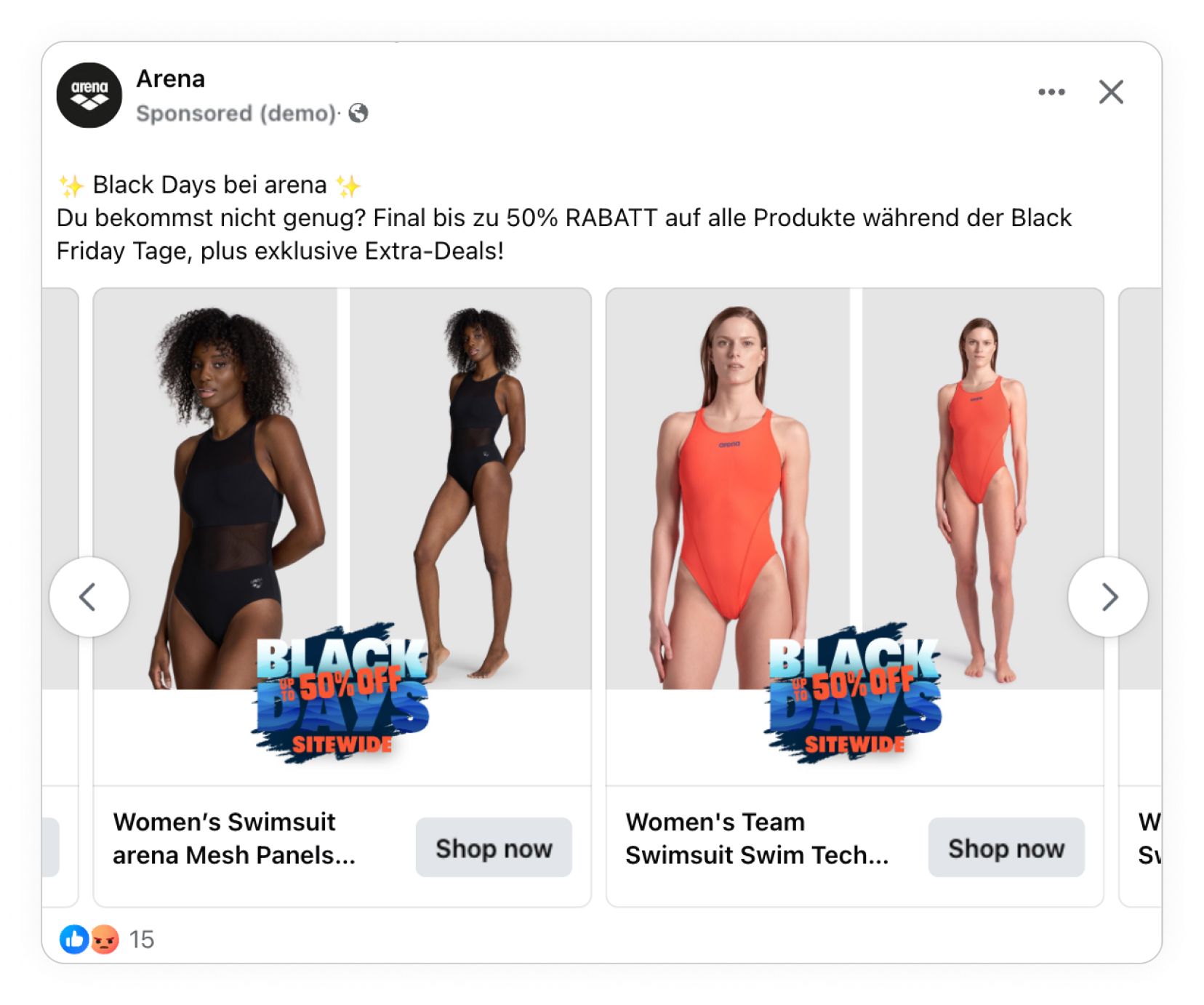
The approach for Black Friday is the same but with a stronger, higher-contrast design. Since shoppers during Black Friday are actively looking for the biggest discounts, Arena ensures that the 50% OFF message dominates the ad.
Another intentional design choice is leaving out the exact sale price. Instead of displaying the discounted price in the ad, Arena encourages curiosity, pushing shoppers to explore the entire sale.
By keeping Catalog Ad structures the same and only updating key elements like the sale message, Arena ensures that sales campaigns run without disruption, shoppers immediately recognize a sale, and the brand stays consistent across all ads.
This approach keeps things simple and effective, allowing Arena to run sales without restarting Meta’s learning phase or setting up new ad sets. Instead of changing everything, they adjust what matters.
 Christiane Schwenk Lagun
Performance Marketing Manger @ Arena
Christiane Schwenk Lagun
Performance Marketing Manger @ Arena
Conclusion
Arena’s journey with Catalog Ads shows what’s possible when you approach them strategically, not just as placements but as a key part of the customer journey.
From testing different design variants, tailoring creatives for different product categories, and creating seamless transitions between ad and product page, to integrating sales messaging without disrupting performance.
By focusing on what information is most useful to the shopper at each stage, Arena has turned their Catalog Ads into tools for both conversion and brand building.
And the results speak for themselves: higher ROAS, stronger CTR, and more informed customers who are ready to buy.
